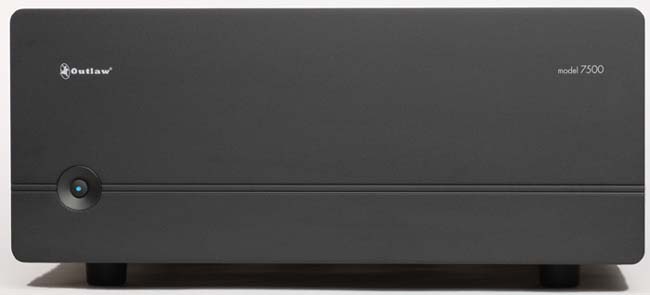

I never thought I'd part with my trusty Outlaw Model 750. The multichannel amp arrived in my system in mid-2001 and was the beginning of my experience with separates. So why am I sitting here with my HTML editor open, writing a review for a Model 7500? The differences between the two amps are both fairly significant (the 7500 is a fully differential design, including the requisite balanced inputs, with a second toroidal transformer) and very subtle (the 7500 offers an extra 35 watts per channel, a detachable power cord, and a more dignified front panel with no sign of the green power button that was once standard issue for Outlaw gear). None of those differences answer our original question – why upgrade?
For many months now, an out-of-town relative of sorts has been bugging me about selling him my Model 750 to help him upgrade his system from an existing stereo setup to a home theater. Initially I wasn't interested, but eventually I decided to think about it a bit. I considered getting a Model 7700, selling him the Model 750 and selling my pair of Model 200 amps on Audiogon to help pay for the new amp. I also considered getting a Model 7500 and keeping the Model 200's. I could probably have done the former and been out slightly less cash overall, but the idea of having a bit of redundancy in the system appealed to me. That's probably a carry-over from my day job and designing building systems to provide some redundancy. The end result was a call to Outlaw shortly before the Model 7500's price increase, with plans to pack up the Model 750 and ship it off to my relation. Lo and behold, about the time I was hooking up the 7500 with some cheap balanced cables ($5 microphone cables), I learned that my relative had gone off in a different direction and didn't want the Model 750 anymore. A frustrated corner of my mind wanted to ship the Model 7500 back to Outlaw before the 30 days ran out so I could put that cash back in my pocket, but by then I'd listened to it...
The Model 750 is no slouch sonically, and it's far from light. It's also visually unremarkable to an almost aggressive degree: gray-black with a slight bevel at the top and an illuminated green power button. The Model 7500's a descendent of the Model 750, albeit with some internal changes (most notably the differential layout and two transformers), but visually it's matured a bit from its older sibling. The faceplate trades the tall bevel and sharp corners for rounded corners and a completely flat face with two notched lines along the bottom, but most notably the big green plastic power button has been replaced by a cleaner black button with a small blue LED indicator at its center.
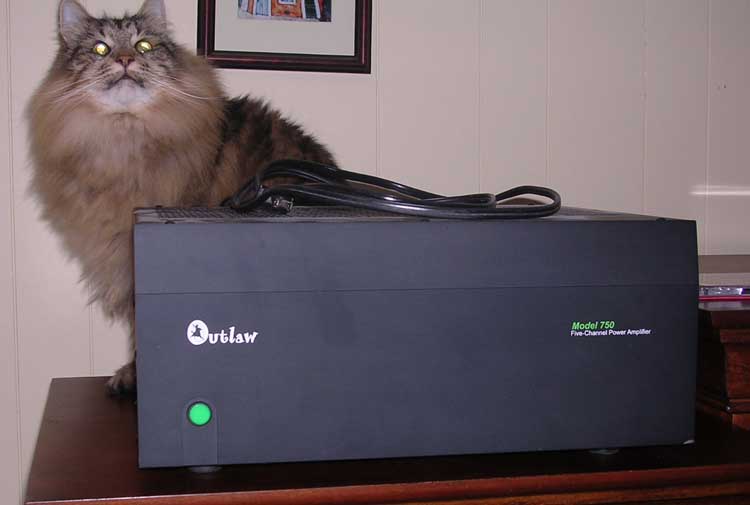
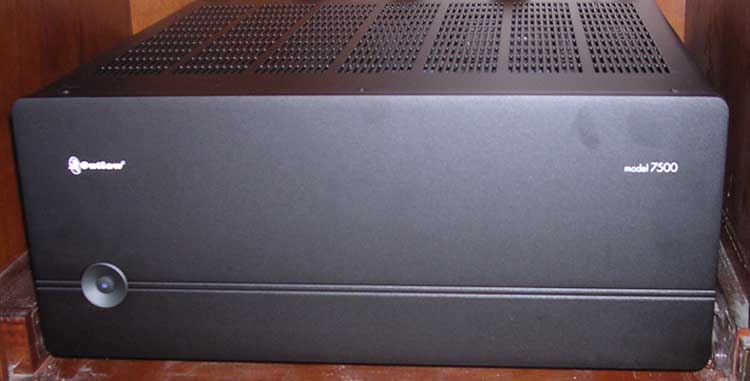
The Model 7500 installed
I was mentally prepared for the Model 7500's weight, more or less. The reality was pretty startling: the amount of copper and aluminum in this chassis is clearly apparent once you attempt to move it at all. Years of working with fans, pumps, and compressors in my job has taught me to respect just how difficult it can be to address the sound generated by rotating equipment. That's why I prefer to rely on amps that handle their heat rejection without mechanical assistance. In this case (as with the Model 750 that I used before), heat rejection is handled by plenty of heat sinks with nice tall aluminum fins.
There's not a lot to setting up an amplifier: hook the pre-amplifier or processor outputs to it, hook the speakers to it, plug it into the wall, and turn it on. When the amp weighs about 80 pounds, you're swapping out seven interconnects, and you're moving seven speaker cables around between two different pieces of furniture, the labor involved gets a bit daunting, but it's still straightforward stuff. Previously, I had been using the Model 200 monoblock amps to drive my Paradigm Reference Studio 60v2 mains while the Model 750 powered my Studio CCv2 center, Axiom M3ti side surrounds, and Studio ADPv2 rear surrounds. With the arrival of the 7500, I shuffled things around a bit so that the mains, center, and rear surrounds. This put the most critical front three speakers and the most lightly used rear surrounds sharing the 7500's lone power cord. It also put all the Paradigms on the same amp. In this new arrangement, the M3ti side surrounds each ended up with a monoblock driving it.
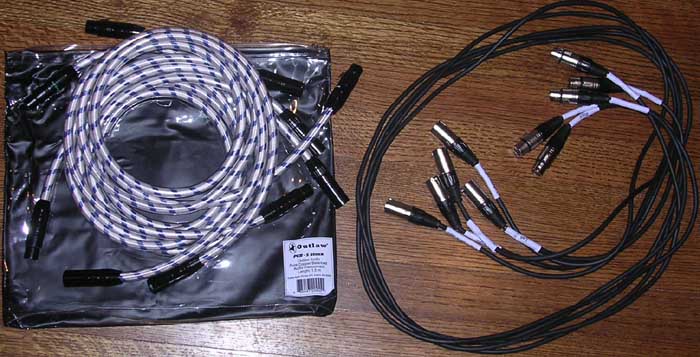
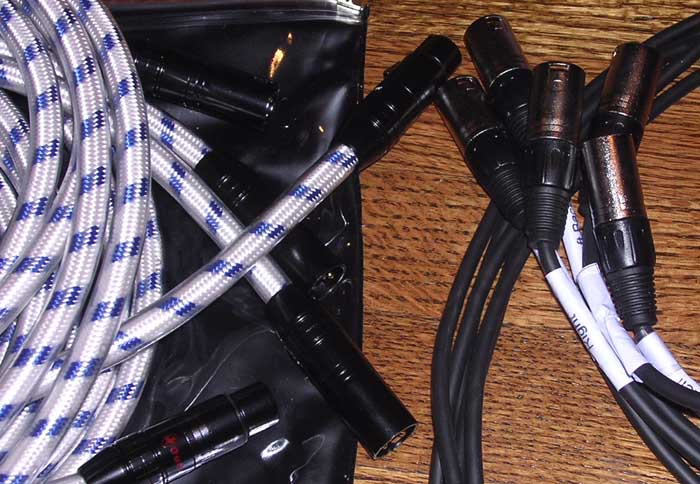
Close-up of PCB's and generic mic cables
For the initial setup, I replaced some pricey unbalanced interconnects (TMC Yellow Labels) with some very inexpensive balanced microphone cables. Just recently, I've swapped out the mic cables for a set of Outlaw's 1.5-meter PCB balanced cables. The PCB five-pack came with each cable's logo printed in a different color – a convenient touch when wiring up your system. I ended up using the red for my left channel, white for right channel, blue for center channel, green for left surround back, and gray for right surround back. After I made all of my connections, I began searching for a list of the THX standard cabling colors to see just how "wrong" my setup was. Google yielded nothing of value, with numerous references to the existence of a color standard but no summary of the standard's color assignments. I ended up finding a picture of the Model 990's rear panel, and it's unbalanced outputs do follow the THX color standard even though it's not a THX certified component (the Ultra2-certified Denon AVR-5805 did not include this standard, oddly enough). I believe that the THX standard is red for the right channel, white for left, green for center, purple for subwoofer, silver for right surround, blue for left surround, yellow for right surround back, and brown for left surround back. Just in case it comes up in Trivial Pursuit one day...
I went into this upgrade with one thing clear in my mind. Having already migrated to separates with good quality amps, I was already in a situation where any change to the amplification in the system should reasonably be classified as the realm of diminishing returns. That's why I initially had no plans to make a changes – short of a hardware failure (such as the aging and faulty two-channel amp that my Model 200's replaced in late 2004), the cost and logistics of making to the amplification a change will serve to only "tweak" the overall sound of the system as compared to changes to the front end or speakers. Still, even diminishing returns can be rewarding sometimes.
As I've said earlier in this review, I moved my Studio 60 mains from the Model 200 monoblocks to the left and right channels of the Model 7500. When these speakers originally shifted from the Model 750 to the monoblocks in late 2004, I found the result to be a somewhat more detailed experience with two-channel listening. Some gains were also had in surround sound due to that upgrade, which I attributed to a combination of the center channel having free run of the Model 750's power supply (since the four surround channels were never going to all place significant demands on the shared power supply at once) and the rear surrounds finally having reliable amplification driving them. Moving the mains yet again (this time from the Model 200's back to the multichannel amp) was a decision that I was of two minds about: on the one hand, I was moving away from a dual monoblock arrangement for the mains (something that was pretty counter-intuitive), but on the other hand I was shifting the mains from an amp that was an unbalanced A/B-G hybrid design to a purely A/B differential platform. When you add in the fact that I was removing unbalanced interconnects that retailed for $160 a pair (TMC Yellow Label) and substituting $5 microphone cables, it may come as no surprise that I had no idea what I might end up hearing once I fired everything back up.
The first thing I did was play a CD in stereo mode (with the 990 set to upsample). What I heard was a "clearer" sound. The two-channel sound was more effortless at the low end (improved detail and clarity) with a smooth, even sound all the way up through the mids and highs. Was this change immediately obvious? It was to me, and it put a nice smile on my face. After five yeras living with these speakers and slowly tweaking and expanding my system, however, I'm pretty keenly aware of slight changes in the system. Unless someone else was pretty familiar with my system to begin with, I doubt that the change would be noticeable – as I said earlier, we're into the realm of diminishing returns, and both the old and new arrangements offer very pleasing audio quality. Multichannel listening was effectively unchanged at low volume levels. That's a reasonable result since low volume levels wouldn't be able to put any stress on any of the amps being shuffled around here. Even at moderate listening levels, however, multichannel material (both DVD and TV) started to exhibit a very subtle increase in clarity. If all I ever did was watch TV and DVD's at moderate volume, the upgrade wouldn't offer much change (call it very diminished returns) – the 750 and M200's were already too good to give the 7500 room for improvement in those circumstances. At closer to reference volumes and for two-channel music listening, however, the 7500 gives my Paradigms a bit of extra clarity that I'll call a "fun" diminished return. Is that an oxymoron? I don't know – I just know that the 7500 made me smile the first time I pushed "play" on a CD.
There is one slight behavioral quirk that caught my attention. It's been mentioned by other 7500 and 7700 owners: unlike the Model 750 and Model 200's, the 7500 produces a faint pop or click when the 990 locks on to a digital signal. The sound isn't loud, but it did begin as soon as the 7500 was added. My wife's generally pretty quick to notice and comment on odd sounds, signal acquisition delays, and other changes in the system's behavior, but this click is subtle enough that it doesn't seem to have caught her attention.
Had it not been for a rather odd series of events, I would not have ended up with a new amp in the system – my Model 750 would have stayed in the equipment rack until something broke or I won the lottery. Nonetheless, that strange (but also fortuitous) series of events has led me to swap the 750 out for its newer brethren, the Model 7500. The exchange has been a pleasant one. Two-channel listening and moderate- to reference-level multichannel listening both benefitted from the presence of the Model 7500. Expecting a "night and day" change in an upgrade like this is pretty unrealistic, but I was pleasantly surprised by the increased detail and clarity that the 7500 provided.